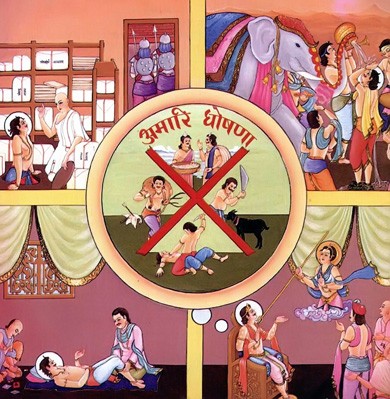
The life of Rajarshi (king with the attributes of a sage) Kumarpal symbolising bravery, justice and compassion and it is a glorious chapter in the saga of Jainism. Kumarpal, an apostle of non-violence, was a powerful monarch. As a man of exceptional talents, he had carved out a niche for himself not only in the history of Gujarat but of India and his life was full of some extraordinary events.
His life was a blend of grievous calamities and glorious achievements, a blend of joys and sorrows. Born in a noble family, he suffered king’s ire, separation from family, thirst and starvation and had to beg and roam in forests. Finally he defeated his enemy, got back his kingdom and embraced religion to die a coveted death. It was a life fit to be a subject of an epic. Profuse details about Kumarpal are available in Dwayashray of Hemchandracharya, in the play Moharajparajay by Yashpal and Kumarpalpratibodh of Somprabhacharya. Such a detailed history of no other king is available in India.
Born in 1093 CE, Kumarpal was married to Bhopaldevi. Siddhraj had no issue and hence Kumarpal was to succeed him to the throne. However Siddharaj did not want Kumarpal to inherit the throne of Gujarat. He wished that Kumarpal died and then was reborn as his son to become the king of Gujarat. He, therefore, tried to kill Kumarpal but didn’t succeed. Hemchandracharya had been kind to him and helped him many a time.
In 1143 CE, at the age of fifty, Kumarpal ascended the throne of Gujarat. At the instance of kalikal sarvagya (all knowing) scholar Hemchandracharya, the new king banned gambling in the kingdom. He proclaimed: “The people at large are violent and are at one another’s throat. Lying is a sin and illicit relationship with a woman is a worse sin; but violence to living organism is the worst of all sins. I ordain that no one should profit from violence. Those who practise violence should give it up and they will be fed at the king’s kitchen for three years if they have no means of subsistence.”
He instructed his officials to give severe punishment to those who indulged in violence. Kumarpal’s devotion to non violence inspired the kings in the neighbouring countries too to practise non-violence. They prohibited any form of violence committed for the sake of religion or livelihood. The offering of animals to goddess kantakeshwari was also prohibited. He closed down slaughter houses at the instance of Hemchandracharya. The compassion for all living organism that one finds in Gujarat is the result of sustained campaign launched by Kumarpal at the instance of Hemchandracharya. He was made to accept the twelve vows of samyaktva and grihastha and Hemchandracharya then conferred on him the title Rajshri (best among the kings).
He also freed Kumarpal from divine curse. His routine included waking up to the chanting of devotional songs, recitation of Vitrag stotra and Yogashastra, partaking of food only after offering it to the gods, lighting of a lamp, singing of psalms and reflecting on the lives of great beings before going to bed. During the period of fourteen years of his rule he donated gold worth crores of rupees, commissioned writing of twenty-one volumes, effected friendship treaties with fourteen countries, undertook seven pilgrimages, constructed 1444 shrines, and renovated 1600 shrines. He is remembered in the history as an ideal king of exceptional talents. In 1173 CE, Hemchandracharya, aged eighty-four, breathed his last and Kumarpal the disciple of the great master, died at the age of eighty in 1174 CE.
Reference
1. Glory of Jainism by Kumarpal Desai










where did he born..? birthplace??